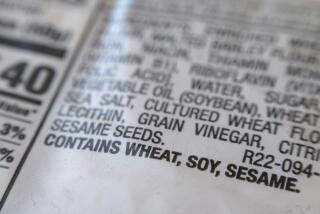Food Trade Agrees to Allergen Labeling
- Share via
In an attempt to head off more restrictive legislation, food industry groups Thursday issued labeling guidelines that would make allergy-causing ingredients easier to identify on processed food packages.
Scientific terms such as “albumen” and “casein” would be replaced on ingredient panels with simpler language such as “eggs” and “milk.” And small amounts of allergy-triggering substances such as peanuts previously exempt from disclosure because they were part of a product’s “natural flavoring” will now be displayed on ingredient lists.
“At least now they’ll be using vocabulary words [people] are familiar with,” said Dr. Sheldon Spector, a Los Angeles-area allergist. “I see too many people who are sensitive to these things getting in trouble.”
The guidelines probably will be adopted by most of the nation’s largest food companies. But allergists and some consumer groups say the measures don’t go far enough to protect the almost 7 million Americans with food allergies. In fact, they say, these measures are simply designed to forestall impending legislation that would force manufacturers to comply.
“We need legislation because these guidelines are completely voluntary,” said Michael Jacobson, executive director of the Center for Science in the Public Interest. “No company has to do anything.”
More than 30,000 people a year are rushed to emergency rooms around the nation with serious allergic reactions to food. Most are given a shot of epinephrine and sent home, but about 2,000 are hospitalized, and as many as 200 of these individuals die each year, according to the American Academy of Allergy, Asthma and Immunology.
The guidelines come just one week before Democrats in the House and Senate plan to introduce legislation that, if enacted, would require all food manufacturers to clearly identify allergens on their labels, or risk fines or other enforcement action from the Food and Drug Administration.
“The industry’s guidelines are long overdue,” Sen. Edward M. Kennedy of Massachusetts, one of the bill’s sponsors, said in a statement. “We simply can’t rely on the industry’s good faith to protect consumers with potentially fatal food allergies.” Kennedy still plans to introduce the bill.
Food industry trade groups argue legislation is unnecessary because these guidelines have broad support across the industry. Food manufacturers say they don’t want to alienate consumers or risk lawsuits with insufficient labeling.
Many big manufacturers such as Hershey Foods and General Mills already have instituted policies that make allergens easier to spot on labels. General Mills, for example, lists these items in bold type or uses separate statements such as “contains milk products.”
However, Jacobson and others worry that smaller manufacturers might not go to the trouble and expense of changing their packaging if they’re not required to do so.
The guidelines target the eight major food allergens that are responsible for 90% of all allergic reactions. They are: shellfish, eggs, fish, milk, peanuts, soy, other tree nuts and wheat.
The guidelines would not require any type of warning or special symbol on the front of the package to identify it as containing a major food allergen, as some activists have sought from the FDA. Food manufacturers say such warnings might scare unaffected consumers unnecessarily.
Nor do the guidelines call for manufacturers that process other foods with known allergens to put statements warning consumers that traces of these products may be present from cross-contamination.
More to Read
Eat your way across L.A.
Get our weekly Tasting Notes newsletter for reviews, news and more.
You may occasionally receive promotional content from the Los Angeles Times.










